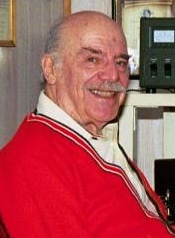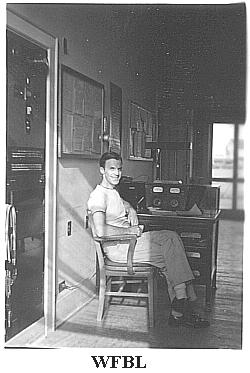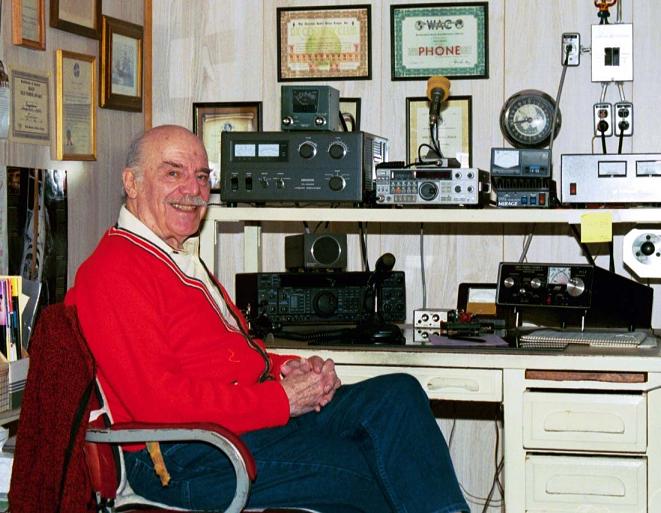 |
George W. Cook Syracuse, NY QCWA # 28125 |
August 7, 2009 George W. Cook Jr., 92, of Syracuse, passed away August 7, 2009 at Francis House. Born in Staten Island, he was a lifelong resident of the Syracuse area. George was a graduate of North High School and Syracuse University. He was a US Navy veteran of WW II.
A contract administrator for General Electric Co., he retired in 1980 after 29 years. He was an enthusiastic member of the Society for the Preservation and Encouragement of Barbershop Quartet Singing in America.
In the 1930s it was the ambition of most hams I knew to work in broadcasting. It was a still a young business with a great deal of mystique and glamour surrounding it. Mention Amos And Andy to young folks of today and there may be a glimmer of recognition, but talk of Myrt And Marge, or Billy Jones And Ernie Hare the "Interwoven Pair" and you might as well be discussing quantum physics. It was the golden age of broadcasting when hardly a radio in the country wasn't tuned at seven o'clock to Amos And Andy. Radio was that magic box that turned your imagination loose with programs like Suspense and Lux Radio Theatre. The boob tube had not yet arrived to do that for you.
True, some hams aspired to become the next Graham MacNamee or Don Wilson, both of whom achieved fame and fortune as announcers and second bananas for Eddie Cantor and Jack Benny respectively. For the more practical, however, it was solving the mystery of tubes, capacitors and resistors that offered greater opportunities. The thought of working at a commercial broadcast station had always been in my mind, although I admit to having thoughts of becoming the next Don Wilson or Graham MacNamee. I was quickly disabused of the idea when I auditioned at WMBO in Auburn, N.Y., and was offered a job at twelve dollars a week. I didn't need a slide rule or a calculator to realize that princely sum wouldn't pay for room and board in Auburn, or permit me to commute from my home in Syracuse. So much for the next Don Wilson. Instead I settled for a more mundane, but better paying job wiring traffic signal controllers at Crouse Hinds Company.
Many of the local hams were members of the Naval Communication Reserve. We tended to think of the Reserve as a big ham club until called to active duty in the early forties. By the end of the forties most of us had been discharged and looking forward to new careers. I had considered attending RCA Institute in New York City as a stepping stone to a life in broadcast engineering, but was persuaded by my Veteran's Administration counselor that four years of college offered a better opportunities for the future. I enrolled in Syracuse University and soon realized I would have to supplement my VA living allowance of $65 a month. Having acquired a Radio Telephone First Class license, I shopped around and found a part time job at WPEA, the police radio station on Grant Boulevard. The hours were terrible and the pay was worse.
Harold Mabes-W2CKY(SK), transmitter supervisor at WFBL and a good friend, mentioned that the station was looking for a part timer to work 20 hours on the weekends and full time during summer vacations. I was out of WPEA quicker than you could say Marconi. I had arrived--I was really in broadcasting.
The building at Collamer was a great facility. It consisted of a large room housing the transmitter, a generator/heat exchanger room, living quarters for the operators, a spare room, which eventually contained a one kilowatt back up transmitter, and a workshop. One of the two garage bays contained a 50KW emergency power generator.
The transmitter was enclosed in a wire cage and occupied a space about fifteen by eight feet. It was a rather ancient, but very reliable Western Electric that was installed when the station was moved from the Onondaga Hotel some time in the late twenties or early thirties. It consisted of a temperature controlled crystal oscillator, a low level modulated buffer, a driver and pair of paralleled water cooled final amplifiers. Power output of 5KW was fed to the 405 foot vertical radiator through a phasing cabinet to allow for a sunset to sunrise directional capability. A shorter tower acted as a director. Three water cooled half wave, three phase rectifiers supplied 15kv at one ampere for the final amplifiers.
Unlike the studio control room personnel who were almost always busy with program activities, there was little to do at the transmitter except to take the required half hour meter readings. When trouble did occur, action was fast and furious, since down time was money. occasional lightning strikes on the antenna would usually just trip easily reset circuit breakers, but some strikes would wipe out the phasing cabinet and that was a major repair.
My four years at WFBL were fun times and the crew was a great bunch to work with. In my last year with the company, an FM transmitter was installed at Pompey. Area coverage was excellent, but FM wasn't popular because few homes at the time had FM receivers. With no ad revenue to support it, FM was considered a bad investment. The station owners also had a TV construction permit, but misjudged the speed with which that medium would spread and let the permit expire. With that miscalculation things began going downhill and the station was sold. By then I was back in the Navy for the Korean War. Most of the old timers at the station had been let go and moved on to other stations or other lines of work. Television had arrived and the radio broadcast game was never the same thereafter.

